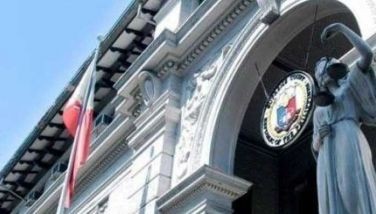Thank you for the screen version
It was in the mid-’70s that one of the longest running — if not the longest running — plays in local theaters began its run on stage: Orlando Nadres’ Hanggang Dito na Lamang at Maraming Salamat, which tells the story of homosexual love.
This happened at a period when local artists began exploring the then delicate issue of homosexuality in various media. In the movies, Lino Brocka did Tubog sa Ginto in 1971 with Eddie Garcia playing the part of a rich businessman married to Lolita Rodriguez, but is having an affair with the family driver, Mario O’Hara, who turns out to be a blackmailer threatening to expose their homosexual relationship.
On television, in the old ABS-CBN in 1972, Panagimpan once cast Marlene Dauden as the unhappy wife of Philip Gamboa, who would rather spend hours in the den of their home playing poker with a buddy (who is never shown on camera). One time, she sneaks in on them and discovers that they do other things aside from play poker. Marlene promptly leaves her husband and the next time they see each other, he had returned from the States looking lovelier than her after a sex change operation.
In Lino Brocka Presents in 1975, Ward Luarca plays a college student who has doubts about his masculinity. Helping him solve the question in his mind is his landlady, Cecilia Lopez (in a rare TV appearance), who volunteers to initiate him into manhood.
Two years later, in another episode of Lino Brocka Presents, Marianne de la Riva invites a boyfriend (who turns out to be a closet queen) to watch Hanggang Dito na Lamang at Maraming Salamat and here we see that even in those days casual plugs were alive and well on Philippine television.
That supposedly subtle message incorporated into the story of Lino Brocka Presents apparently worked wonders for Hanggang Dito na Lamang at Maraming Salamat because aside from playing in Manila, there were also provincial tours and, later, was even staged in the US in the mid-’80s.
And now, Hanggang Dito na Lamang is already a digital movie directed by Lino Tañada (he studied film in the
Exhibited recently in Robinsons IndieSine venue, Hanggang Dito is the story of a gay man still in the closet (Nonie Buencamino doing the role originated on stage by Lino Brocka), who attends to the financial needs of a young man (Jerwin Mercado taking on the part first done by Bembol Roco) he had always treated as a son. Even if he had seen the boy grow up and is practically his son, he still develops romantic feelings for his ward, but keeps this to himself. His situation becomes even more complicated when he discovers that the young man is homophobic. The title of Hanggang Dito is such because whenever the young man writes from
I never got to see any of the numerous stage presentations of Hanggang Dito na Lamang at Maraming Salamat and I have no way of pointing out the changes (if any) in the story it underwent when it made the transition as a play to a material for the big screen.
In the beginning, however, its original theatrical form keeps rearing its head in the dialogues and even in the way some of the scenes are staged. But in time, everything falls in place and the material finally adjusts and blends well into the film medium.
Some of the technical elements — like Willy Cruz’s beautiful but unobtrusive music — give the film adaptation a more cinematic touch. By the time we get to the middle part, the stagy feel is totally gone and there is no more stiffness to it.
Even the performance of newcomer Jerwin Mercado improves as the film moves along. (Could they have shot it chronologically?) In the beginning, Mercado is hopelessly wooden, but gets more comfortable with every scene until he gives an above-average performance in his more demanding sequences toward the end.
Jon Santos as the flaming beauty shop owner adds a lot of life and humor to the film with his colorful dialogues and the talent he lends to every line he delivers on screen. Although he comes out like he’s doing one of his stand-up comedy acts in some scenes, he is generally very effective in his role as a cross-dresser. He basically utilizes to the fullest his gift as a performer in the movie. His best scene, however, is in the film’s climax — a dramatic showdown with the film’s lead character.
It is Nonie Buencamino who is actually consistent with his performance as a repressed homosexual who has to deal with unrequited love. An accomplished character actor who has awards to his name, Buencamino is particularly brilliant in Hanggang Dito na Lamang.
As for the film itself, I can’t say if it is an improvement over the play because I have no basis for comparison. But for sure, this film version by Lino Tañada is very entertaining. It may have gotten off to a slow start, but the pacing gets faster (and the film more interesting) along the way.
The plot of Hanggang Dito na Lamang at Maraming Salamat doesn’t show its age either — except maybe instead of communicating via snail mail, they should be texting. (But can you imagine what the updated title would be like: Up 2 here only n ty. Not very cinematic.) Its theme will always be relevant for as long as there is no full acceptance of homosexuality in society.
- Latest
- Trending

































